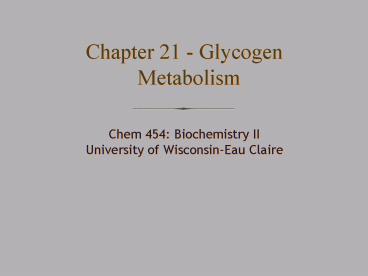Chem 454: Biochemistry II - PowerPoint PPT Presentation
Title:
Chem 454: Biochemistry II
Description:
Chem 454: Biochemistry II – PowerPoint PPT presentation
Number of Views:41
Avg rating:3.0/5.0
Title: Chem 454: Biochemistry II
1
Chapter 21 - Glycogen Metabolism
- Chem 454 Biochemistry II
- University of Wisconsin-Eau Claire
2
Introduction
- Glycogen
- A storage form of glucose
3
Introduction
- Glycogen is stored primarily in the liver and
skeletal muscles. - Liver - used for maintaining blood glucose levels
- Muscles - used to meet energy needs of the muscles
4
Introduction
- Glycogen degradation occurs in three steps
5
Introduction
- Glycogen synthesis uses activated precursor
UDPglucose
6
Introduction
- Regulation of glycogen metabolism is complex.
- Allosteric regulation to meet the needs of the
cell - Hormonal regulation to meet the needs of the
organsim
7
The Big Picture
8
Fuel Reserves
9
Fuel Reserves
10
Glucose Homeostasis
11
Glucose HomeostasisIntegrated metabolic
regulation
12
Details, DetailsGlycogen Breakdown
- Requires three enzymes and produces glucose
6phosphate - Glycogen Phosphorylase
- Debranching Enzyme
- Phosphoglucomutase
- In the liver, an additional enzyme produces free
glucose - Glucose 6phosphatase
13
Phosphorylase
- Cleavage uses orthophosphate in phosphorolysis
reactions
14
Debranching Enzyme
- Two enzymes activities are needed to deal with
the a1,6 branch points
15
Phosphoglucomutase
- Mechanism is like that of phosphoglycerate mutase
16
Glucose 6-phosphatase
- Enzyme is found primarily in the liver and is
used to release glucose into the bloodstream
17
Mechanism for Phosphorolysis
18
Mechanism for Phosphorolysis
- Pyridoxyl phosphate coenzyme
19
Mechanism for Phosphorolysis
20
Regulation of Phosphorylase
- Phosphorylase is regulated by several allosteric
effectors that signal the energy state of the
cell - It is also regulated by reversible
phosphorylation in response to the hormones
insulin, epinephrine, and glucagon
21
Muscle Phosphorylase
22
Muscle Phosphorylase
23
Muscle Phosphorylase
24
Liver Phosphorylase
25
Phosphorylase Kinase
26
Epinephrine and Glucagon
- Epinephrine and glucagon signal the need for
glycogen breakdown - Epinephrine stimulates glycogen breakdown to a
greater extent in the muscle than the liver.
27
Epinephrine and Glucagon
- Epinephrine and glucagon signal the need for
glycogen breakdown - Glucagon is a peptide hormone that is secreted by
the acells of the pancreas when blood glucose
levels are low
28
Epinephrine and Glucagon
29
G-protein Signal Transduction
- Epinephrine binds to a 7TM receptor
30
G-protein Signal Transduction
- Glucagon also binds to a 7TM receptor
31
aAdrenergic Receptors in Liver
- In the liver, epinephrine also binds to
aadrenergic receptors, which activate the
phosphoinositide signal transduction pathway - Release of inositol 1,4,5trisphosphate by
phospholipase C induces the release of Ca2 from
the ER. - Binding of Ca2 to calmodulin partially activates
phosphorylase kinase
32
aAdrenergic Receptors in Liver
33
Turning It Off
- Glycogen breakdown can also be rapidly turned
off. - GTPase activity of the Gproteins
- cAMP phosphodiesterase
- Protein kinase A also phophorylates the asubunit
of phosphorylase kinase. This makes it more
susceptible to dephosphorylation (inactivation)
by protein phosphatase 1 (PP1)
34
Glycogen Synthesis vs Degradation
- Different pathways are used for the synthesis and
degradation.
35
UDP-Glucose
- UDP-Glucose is an activated form of glucose
36
Glycogen Synthesis
- UDP-Glucose is an activated form of glucose
37
Glycogen Synthase
38
Branching Enzyme
39
Branching Enzyme
40
Regulation of Glycogen Synthase
- Glycogen Synthase is also regulated by
phosphorylation - Protein kinase A catalyses the phosphorylation
- Glycogen synthase a is the more active,
dephosphorylated form - Glycogen synthase b is the less active,
phosphorylated form
41
Glycogen is an Efficient Storage Form of Glucose
- Only 1 equivalent of ATP is used for storing each
glucose unit
42
Reciprocal Regulation ofSynthesis vs Breakdown
- Regulation by hormone triggered c-AMP cascade
43
Protein Phosphatase 1
- PP1 reverses regulatory effects of kinases
- PP1 dephosphorylates
- glycogen phosphorylase
- phosphorylase kinase
- glycogen synthase
44
Protein Phosphatase 1
- PP1 is inactivated by the hormone-triggered c-AMP
cascade
45
Insulin Activates Glycogen Synthase
- The insulin-triggered tyrosine kinase cascade
46
Regulation by Blood Glucose
- Blood glucose levels regulate glycogen metabolism
in the liver
47
Diseases of Glycogen































